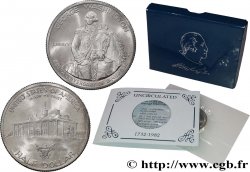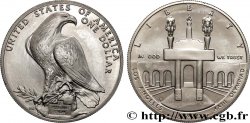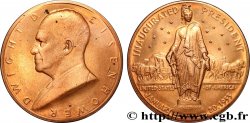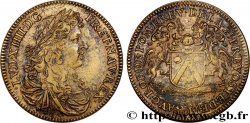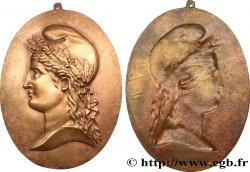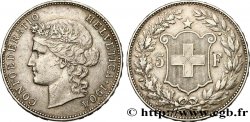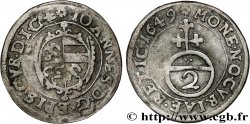Live auction - fme_701368 - ESTADOS UNIDOS DE AMÉRICA Médaille, Assassinat d’Abraham Lincoln, Hommage de la France
Usted debe firmar y ser un comprador aprobado para pujar, Inicia sesión para pujar. Las cuentas están sujetas a la aprobación y el proceso de aprobación se alcanzan dentro de las 48 horas. No espere hasta el día en una venta se cierra el registro.Al hacer una oferta en este artículo usted está firmando un contrato jurídicamente vinculante para comprar este artículo y haga clic en «oferta» constituye una aceptación de los términos de uso de live auctions de cgb.fr.
La subasta debe ser colocado en euros enteros cantidades venta only.The se cerrará en el momento en la descripción del artículo, no se ejecutarán las ofertas recibidas en el sitio después de la hora de cierre. Veces Transmition pueden variar y las ofertas pueden ser rechazadas si espera a los últimos segundos. Para más información envie el FAQ Live auction.
Las ofertas ganadoras estarán sometidas a un 18% IVA incluido por gastos de participación a la venta.
Las ofertas ganadoras estarán sometidas a un 18% IVA incluido por gastos de participación a la venta.
| Valoración : | 400 € |
| Precio : | 686 € |
| Oferta más alta : | 800 € |
| Fecha de fin de la venta : | 07 diciembre 2021 20:20:33 |
| participantes : | 2 participantes |
Tipo : Médaille, Assassinat d’Abraham Lincoln, Hommage de la France
Fecha: 1865
Metal: bronce
Diámetro: 82,5 mm
Eje de acuñación: 12 h.
Acuñador MAGNIADAS Franky
Peso: 286,1 g.
Canto: lisse
Cuño: sans poinçon
Grado de rareza: R2
Comentarios sobre el estado de conservación:
Patine hétérogène avec des concrétions dans le creux des reliefs. Présence de coups et rayures, notamment dans le champ de l’avers à 2 heures. Manque de métal sur la tranche à 2 heures, des traces de limage sur la tranche
N° en los catálogos de referencia :
Pedigrí:
Cet exemplaire provient d’une ancienne vente Chaponnière, lot 662, Auction 10
Anverso
Titulatura del anverso: DÉDIÉ PAR LA DÉMOCRATIE FRANÇAISE A LINCOLN PRÉSIDENT DEUX FOIS ÉLU DES ÉTATS-UNIS.
Descripción del anverso: Tête de profil à gauche, signé : FRANKY MAGNIADAS.
Reverso
Titulatura del reverso: LINCOLN - L’ - HONNÊTE HOMME / ABOLIT L’ESCLAVAGE RÉTABLIT L’UNION / SAUVA LA RÉPUBLIQUE / SANS VOILER LA STATUE DE LA LIBERTÉ / IL FUT ASSASSINÉ LE 14 AVRIL / 1865 // À L’EXERGUE : LIBERTÉ - ÉGALITÉ - FRATERNITÉ.
Descripción del reverso: Stèle timbrée d’une légende en 6 lignes sommé d’un fronton triangulaire timbré d’une équerre, un pendule et des branchages. Victoire ailée à gauche, vêtue d’une côte de maille, une couronne dans une main, s’appuyant sur une ancre avec l’autre main. Deux hommes à demi vêtus à droite, l’un d’eux tient une palme et l’autre tient une baïonnette. Locomotive à vapeur à droite et navire à gauche. Aigle américain tenant une banderole et des flèches au dessus de la scène. Signé : FRANKY = MAGNIADAS.
Comentario
Citation dans l’ouvrage de Jean-Pierre Collignon : Cette pièce d'une qualité exceptionnelle est probablement la plus remarquable produite sous le second empire. Rien n'y manque : le grain de peau, les veines, les rides du Président. Cette finesse d'exécution et cette grande maîtrise de l'équilibre du sujet allégorique font de Franky Magniadas, artiste moins connu car de production restreinte, le plus grand graveur du XIXe siècle. Au commencement de 1864, le sud semblait perdu. Il se releva un moment par des efforts désespérés. Une dictature implacable fit de tout ce qui lui restait de territoire un vaste camp ; le gouvernement sudiste poussa la guerre sans trêve ni merci, en foulant aux pieds toute loi, tout droit, toute humanité. Cette féroce énergie eut quelques mois de succès : les hommes du Nord, mal commandés, opérant sans ensemble, éprouvèrent nombre d'échecs partiels ; mais le nouveau général en chef, Grant, rétablit la situation. La victoire revint au Nord dans l'intérieur ainsi que sur les côtes. La grande loi qui affranchit définitivement les noirs fut votée le 31 janvier 1865. Ce qu'avait commencé 1864, 1865 l'acheva : le printemps vit tomber les principales places rebelles et capituler leur habile général en chef, Lee. Un partisan du Sud, Booth, voulut venger la défaite des esclavagistes en assassinant le Président. Le 14 avril 1865, entré clandestinement au théâtre Ford à Washington dans la loge présidentielle armé d'un pistolet, il tira dans le dos de M. Lincoln, et profitant du tumulte, put s'échapper par les coulisses. Le blessé fut transporté dans l'hôtel meublé face au théâtre, perdant son sang en abondance. La foule s'amassa devant la porte en silence, les uns pleurant, les autres priant. Ils ne partirent qu'au matin du 15 avril lorsqu'on eut annoncé la mort du Président. Ce crime ne pouvait relever une cause perdue ; Lincoln mourrait victorieux, son nom demeurant à jamais associé à l'abolition de l'esclavage. On peut ajouter à Collignon quelques éléments significatifs. Dès 1865, il fut décidé de faire une médaille d'or de Lincoln, à remettre à sa veuve, financée par souscription de 10 centimes par souscripteur (40.000 souscripteurs se manifestèrent). Un Comité de la médaille Lincoln fut créé, chargé de la souscription, avec des membres comme Victor Hugo, Victor Schœlcher, Louis Blanc ou Edgar Quinet. En 1866, l'orfèvre Franky Magniadas réalise les coins de cette médaille, qui fut fabriquée à Genève, devant l'opposition de Napoléon III. Le 1er décembre 1866, la médaille fut remise à Mme Abraham Lincoln, avec une lettre de vingt personnalités françaises dont Victor Hugo. Elle figura à l'Exposition Universelle de 186.
Quote from the work of Jean-Pierre Collignon: This piece of exceptional quality is probably the most remarkable produced under the Second Empire. Nothing is missing: the President's skin texture, veins, and wrinkles.. This finesse of execution and this great mastery of the balance of the allegorical subject make Franky Magniadas, a lesser-known artist because of his limited production, the greatest engraver of the 19th century.. By the beginning of 1864, the South seemed lost.. He got up for a moment with desperate efforts. A relentless dictatorship made all its remaining territory a vast camp; the southern government pushed the war without truce or mercy, trampling underfoot all law, all right, all humanity.. This fierce energy had a few months of success: the men of the North, poorly commanded, operating without unity, experienced a number of partial failures; but the new general in chief, Grant, restored the situation. Victory returned to the North in the interior as well as on the coasts. The great law that definitively freed black people was passed on January 31, 1865.. What 1864 had begun, 1865 completed: spring saw the fall of the main rebel strongholds and the capitulation of their able general-in-chief, Lee.. A Southern supporter, Booth, wanted to avenge the defeat of the slaveholders by assassinating the President.. On April 14, 1865, he entered the Ford Theatre in Washington, D.C., into the presidential box armed with a pistol, and shot M.. Lincoln, taking advantage of the tumult, was able to escape through the wings. The wounded man was taken to the furnished hotel opposite the theatre, losing profuse blood.. The crowd gathered in front of the door in silence, some weeping, others praying.. They did not leave until the morning of April 15 when the President's death was announced.. This crime could not lift a lost cause; Lincoln would die victorious, his name forever associated with the abolition of slavery.. We can add some significant elements to Collignon. As early as 1865, it was decided to make a gold medal of Lincoln, to be given to his widow, financed by a subscription of 10 cents per subscriber (40. 000 subscribers came forward). A Lincoln Medal Committee was created, responsible for the subscription, with members such as Victor Hugo, Victor Schœlcher, Louis Blanc and Edgar Quinet.. In 1866, the goldsmith Franky Magniadas created the dies for this medal, which was made in Geneva, in the face of opposition from Napoleon III.. On December 1, 1866, the medal was presented to Mrs. Abraham Lincoln, along with a letter from twenty French personalities including Victor Hugo.. It appeared at the Universal Exhibition of 186
Quote from the work of Jean-Pierre Collignon: This piece of exceptional quality is probably the most remarkable produced under the Second Empire. Nothing is missing: the President's skin texture, veins, and wrinkles.. This finesse of execution and this great mastery of the balance of the allegorical subject make Franky Magniadas, a lesser-known artist because of his limited production, the greatest engraver of the 19th century.. By the beginning of 1864, the South seemed lost.. He got up for a moment with desperate efforts. A relentless dictatorship made all its remaining territory a vast camp; the southern government pushed the war without truce or mercy, trampling underfoot all law, all right, all humanity.. This fierce energy had a few months of success: the men of the North, poorly commanded, operating without unity, experienced a number of partial failures; but the new general in chief, Grant, restored the situation. Victory returned to the North in the interior as well as on the coasts. The great law that definitively freed black people was passed on January 31, 1865.. What 1864 had begun, 1865 completed: spring saw the fall of the main rebel strongholds and the capitulation of their able general-in-chief, Lee.. A Southern supporter, Booth, wanted to avenge the defeat of the slaveholders by assassinating the President.. On April 14, 1865, he entered the Ford Theatre in Washington, D.C., into the presidential box armed with a pistol, and shot M.. Lincoln, taking advantage of the tumult, was able to escape through the wings. The wounded man was taken to the furnished hotel opposite the theatre, losing profuse blood.. The crowd gathered in front of the door in silence, some weeping, others praying.. They did not leave until the morning of April 15 when the President's death was announced.. This crime could not lift a lost cause; Lincoln would die victorious, his name forever associated with the abolition of slavery.. We can add some significant elements to Collignon. As early as 1865, it was decided to make a gold medal of Lincoln, to be given to his widow, financed by a subscription of 10 cents per subscriber (40. 000 subscribers came forward). A Lincoln Medal Committee was created, responsible for the subscription, with members such as Victor Hugo, Victor Schœlcher, Louis Blanc and Edgar Quinet.. In 1866, the goldsmith Franky Magniadas created the dies for this medal, which was made in Geneva, in the face of opposition from Napoleon III.. On December 1, 1866, the medal was presented to Mrs. Abraham Lincoln, along with a letter from twenty French personalities including Victor Hugo.. It appeared at the Universal Exhibition of 186







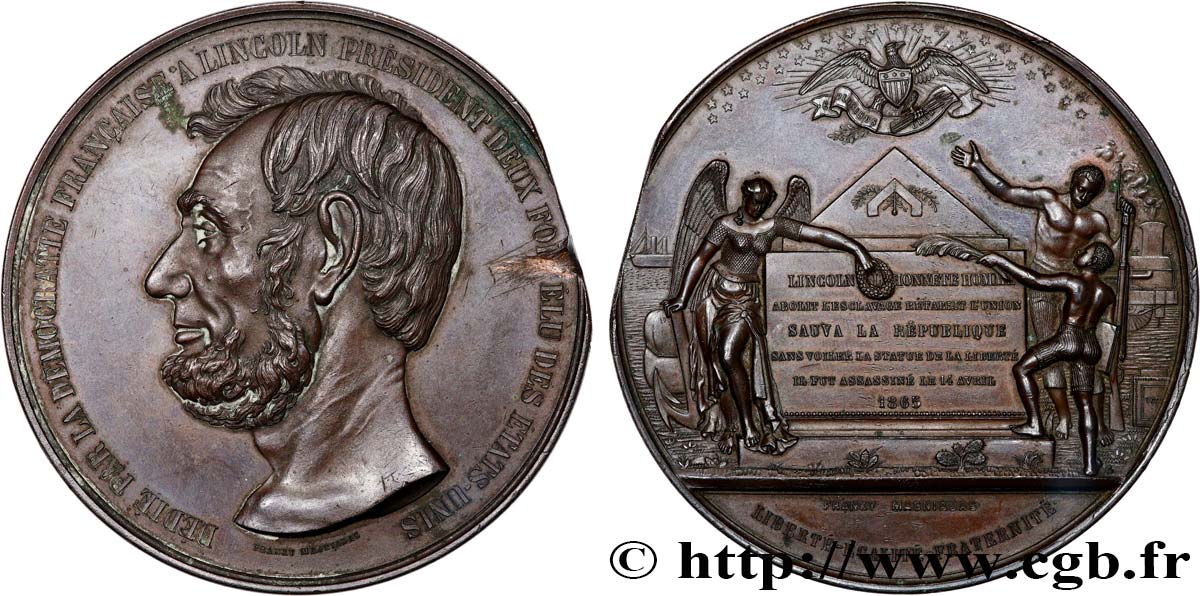
 Informar de un error
Informar de un error Imprimir la página
Imprimir la página Comparte mi selección
Comparte mi selección Haz una pregunta
Haz una pregunta Consignar / vender
Consignar / vender
 Descriptivo
Descriptivo
